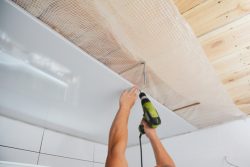What is a Wall Vapor Barrier?
 A wall vapor barrier is an essential component of building construction that plays a crucial role in preventing moisture infiltration and ensuring the longevity and durability of structures. It acts as a protective layer, preventing the penetration of moisture into the wall assembly, mitigating the potential damage that can result from moisture accumulation over time.
A wall vapor barrier is an essential component of building construction that plays a crucial role in preventing moisture infiltration and ensuring the longevity and durability of structures. It acts as a protective layer, preventing the penetration of moisture into the wall assembly, mitigating the potential damage that can result from moisture accumulation over time.
Understanding the Threat of Moisture
Moisture infiltration in wall assemblies can lead to various adverse effects, including mold and mildew growth, wood rot, corrosion, and structural damage. Moisture can enter through various sources such as rain, groundwater, and condensation. Even in areas with minimal rainfall, moisture can still be a concern due to the natural process of water vapor diffusion.
The Purpose of a Wall Vapor Barrier
A wall vapor barrier is designed to control the movement of moisture into the wall assembly. Its primary purpose is to prevent the condensation of water vapor by maintaining a continuous barrier against the flow of moisture. It accomplishes this by reducing the permeability of the wall assembly to water vapor, ensuring that moisture cannot pass through and accumulate within the structure.
Types of Wall Vapor Barriers
There are several types of wall vapor barriers available, each offering specific advantages and suitability for different types of construction projects. Here are three common types:
1. Polyethylene Film: Polyethylene is a widely used material for vapor barriers due to its durability and affordability. It is a plastic sheet that can be installed on the warm side of the wall assembly, effectively blocking moisture from entering.
2. Foil-Faced Insulation: Foil-faced insulation combines both insulation and vapor barrier properties. It consists of a layer of foam insulation with a reflective foil layer on one side. The foil acts as a vapor barrier, preventing moisture from penetrating the wall assembly.
3. Liquid Applied Membrane: Liquid applied membranes are a more modern approach to wall vapor barriers. They are typically sprayed or rolled onto the surface and can offer superior adhesion and flexibility compared to traditional sheet membranes.
Installation Considerations
Proper installation of a wall vapor barrier is vital to its effectiveness. Here are some important considerations:
1. Placement: The vapor barrier should be installed on the interior side of the wall assembly, facing the conditioned space. This ensures that the warm, moist air inside the building does not migrate through the wall and condense on the colder exterior surfaces.
2. Sealing: All seams and penetrations in the vapor barrier must be properly sealed to maintain its integrity. Any gaps or openings can allow moisture to bypass the barrier, rendering it ineffective.
3. Perforation: While a vapor barrier prevents the entry of moisture, it also impedes the escape of trapped moisture. To promote moisture evaporation, some vapor barriers are designed with tiny perforations that allow moisture to escape while still preventing bulk water infiltration.
Benefits of a Wall Vapor Barrier
Installing a wall vapor barrier brings numerous benefits that significantly enhance the longevity and performance of buildings. These benefits include:
1. Moisture Damage Prevention: By effectively preventing moisture infiltration, a vapor barrier safeguards the structural integrity and prevents damage caused by moisture-related issues such as mold growth, wood rot, and corrosion.
2. Energy Efficiency: A properly installed vapor barrier reduces air leakage, enhancing the energy efficiency of the building. It helps maintain a comfortable indoor environment by preventing the escape of conditioned air and restricting the entry of outdoor air.
3. Increased Lifespan: The presence of a reliable vapor barrier increases the lifespan of the entire wall assembly by protecting against moisture-related deterioration.
Conclusion
A well-designed and properly installed wall vapor barrier is crucial for maintaining the long-term performance and durability of buildings. By preventing moisture infiltration and its associated problems, a vapor barrier plays a vital role in protecting structures from costly damage while also enhancing energy efficiency. When it comes to building construction, investing in a high-quality vapor barrier is a smart choice for long-term building performance.
Got Questions? Let Us Help!
Categorised in: Wall Vapor Barriers

 HPEC is an active member of CAGE
HPEC is an active member of CAGE